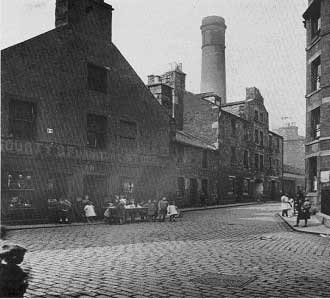|
Memories of a childhood in wartime Leith. The trials and tribulations of the period, allied to the camaraderie of the community in facing up to an uncertain future made a lasting impression on John Stewart.
The Second World War was only months away when I was about to be uprooted. My parents secured the tenancy of a one-room flat or, as they were called then, a single end in Bonnington Road, Leith. This was in an old tenement building popularly known as 'The Bowery'.
Although I was their only child, it was felt I would be better off staying with my grandparents who were only too pleased to have me with them. This would be the last time I saw or heard from my paternal grandmother until fate brought us face-to-face 21 years later.
With the call-up of many men folk for military service, there was an acute shortage of labour for work. My mother took a job with Crawfords, a biscuit manufacturer in Elbe Street.
My father was excused military service by virtue of him being a member of the Auxiliary Fire Service. This was later designated the National Fire Service and he was recruited into it forthwith. Allied to his trade as a brass-moulder, he was permanently exempted from the armed forces. 
Cables Wynd junction with Giles Street with the cooperation buildings on the right. (Courtesy of Edinburgh Room, Central Library)
I moved in with my grandparents just prior to the War's beginning in September 1939. There were six houses in the stair with two on each flat with the doors opening in from an open balcony. The balconies led off from the communal stair.
The balconies overlooked a scrap metal yard owned by 'wingy' Robertson, so called because he had a withered arm that was bent upwards across his chest. Much of his work was dealing in wrecked cars. My grandmother was given an old car seat from him that she had placed on her balcony. This was greatly used during the summer months.
The house itself consisted of a kitchen/cum bedroom, the bed being contained in a recess, a small room that contained a double bed, a wardrobe and a chest of drawers. There was also a lavatory off the small lobby.
My grandfather and I shared the bed in the kitchen while my grandmother and my two aunties, Chrissie and Peggy, had the other bedroom. On the wall at the foot of their bed hung other clothes that had a permanently draped curtain over them.
My aunts, Chrissie and Peggy were still resident in the little house for the first few years of the war. Both worked in the Wireworks at Granton.
They were active in the Salvation Army that had a great influence on the family. Chrissie to her dying day in 1982 would continue to wear the uniform. She was never to marry. Peggy did leave it when she married in 1942 and went to stay in Newhaven.
No space was wasted, even the beds stood on blocks that enabled storage room beneath them. The walls were colourfully distempered to within two feet of the ceiling where they were topped by a narrow border of floral paper. Above this the frieze and ceiling were whitewashed.
In the kitchen the ceiling soon lost its light hue because of the rising vapours from the old gaslight mantle. On the wall at the foot of my bed hung a faded picture of my uncle George who had died at the age of 11 years old.
Alongside it was an old wall clock with its distinctive tick-tock that seemed to get louder when the light was extinguished. Many were the times when I lay awake counting off the seconds along with it. The kitchen was the only room that had lighting. The others were completely in darkness as night fell.
We had one window in the kitchen that was fronted by the sink and the scrubbed wooden bunker. Many were the times I sat on this with my feet in the basin as my legs were scrubbed to remove the day's grime.
The other window was in the bedroom. The toilet had a WC and no more. A small window from this room looked out on to the balcony. This was kept secure by a large nail that could be inserted or withdrawn to allow it to be opened or shut.
Both main windows were in two halves and were opened with the assistance of two lead counter weights housed in the side casements. Often the ropes suspending these weights frayed and broke making the opening procedure more difficult.
My mother regularly washed these windows for my grandparents. She would sit out on the sill with her legs to the inside and pull the bottom half of the window down onto them. After this she would pull the top half down and likewise wash it. Considering we were one flat up she was quite fearless in doing what she did.
The building was old and mice were always a problem. As cats were not a favourite pet, mousetraps were the only means of keeping the vermin at bay.
Lying in bed at night, I could often hear the trap being sprung. Another blighter had been caught and I took my turn at emptying the trap the following morning.
I should point out that this in no way reflected the house's standard of cleanliness. We were in not alone in this fight against vermin. Sometimes the problem got so bad that the sanitary fumigation officials had to be called in.
This was the last resort for it was seen as a lasting shame to have to do so. The conditions prevailing at this time were atrocious and it was a credit to those families in making the best of them.
John Stewart, 2001
| |


